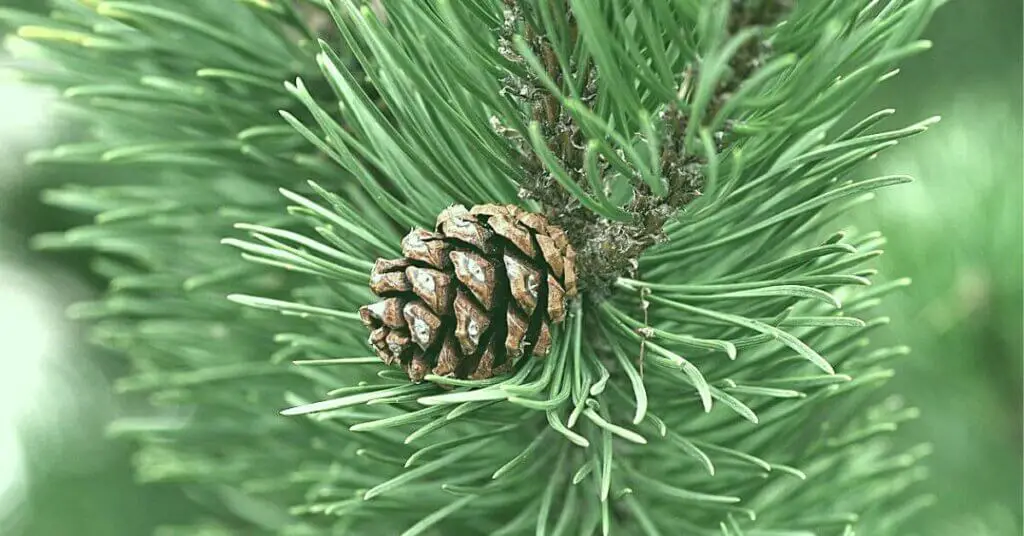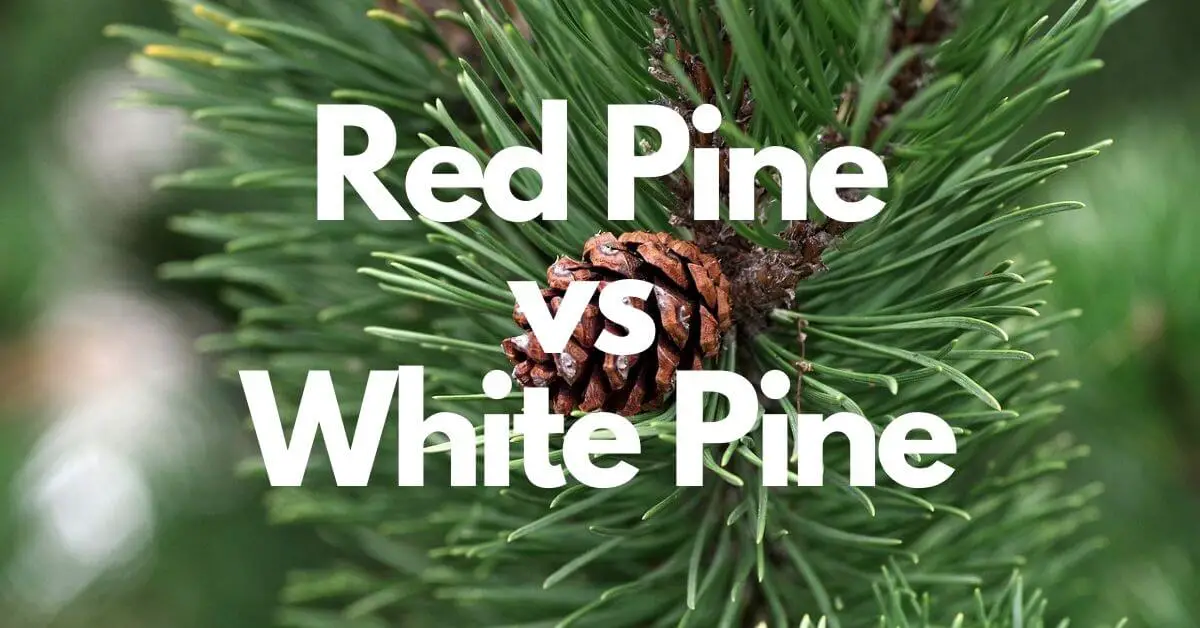White pine is softer than red pine. Red pines are reddish-brown and white pines are brown to reddish in color. Both species are easy to work with both hand and machine tools.
Pine is not usually a rot-resistant wood, but the heartwood is rated as moderate to low in rot resistance. Pine requires regular care and maintenance to last a long time.
Red Pine
Red Pine is a coniferous evergreen tree, native to North America. The reason for its name being “Red” pine is that the red color may be seen in the fissures in the bark. Its leaves are needle-like and produce fruit like the cone.
Red pine wood is hard and straight-grained. It has medium density and is widely used for paper, and construction lumber.
White Pine
White pine is commonly known as the eastern white pine, northern white pine, and western white pine. Native to eastern America and western white pine is native to western America.
All Pine species are very similar to each other. but there is a difference in some properties between them, such as tree height, wood hardness, weight, etc.
Pine is an evergreen softwood. Eastern White Pine Wood is suitable for construction lumber, carving, and boatbuilding, and Western White Pine is good for veneer, plywood, crates, boxes, wooden matches, and interior millwork.
| # | Red Pine | Eastern White Pine | Western White Pine |
| Scientific name | Pinus resinosa | Pinus strobus | Pinus monticola |
| Tree Height | 65-100 ft (20-30 m) tall | 65-100 ft (20-30 m) | 98–164 ft ( 30–50 m) |
| Trunk Diameter | 2-3 ft (.6-1 m) | 2-4 ft (.6-1.2 m) | 3-5 ft (1-1.5 m) |
| Dried Weight | 34 lbs/ft3 (545 kg/m3) | 25 lbs/ft3 (400 kg/m3) | 27 lbs/ft3 (435 kg/m3) |
| Janka Hardness | 560 lbf (2,490 N) | 380 lbf (1,690 N) | 420 lbf (1,870 N) |
| Wood Color | Pale Yellow to Reddish Brown | Light brown to the reddish hue | Light brown to the reddish hue |
| Rot Resistance | Not Rot Resistance | Not Rot Resistance | Not Rot Resistance |
| Workability | Good | Great | Good |
| Uses | Posts, railroad ties, paper (pulpwood), and construction lumber | Construction lumber, carving, and boatbuilding. | Plywood, interior millwork, carving, and construction lumber. |
Uses of Red Pine and White Pine
1. Flooring
Many people believe that softwood is not suitable for flooring because softwood is weaker than hardwood. But this is not 100% correct. Many softwoods are excellent choices for flooring.
Red pine is harder than white pine, but it is still a softwood species. There are chances of getting dents and scratches. But there is still a demand for making the floor because it is inexpensive and has less sound than hardwood while walking on it.
White Pine is also a great choice for flooring. It is durable and easily available. White pine flooring lasts about 100 to 120 years with regular maintenance and care.
2. Furniture
Red pine is a strong, shock-resistant, easy-to-work material for making quality furniture. But it is not as good as oak. High-grade pine wood has fewer knots, which is considered good for furniture.
Pressure-treated pine is a great option for exterior and interior furniture that has been chemically treated to resist rot, decay, and termites.
White Pine is less dense than Yellow Pine and Red Pine. Therefore, it is not suitable for outdoor furniture. Because it is less stable.
Pine Wood moves in small amounts with seasonal changes in temperature and humidity. White pine may be a better choice for furniture but depends on what kind of furniture building.
3. Crates and Boxes
Red pine is not used much for boxes and crates because it is denser and heavier than white pine. The second reason is that it gets a little more expensive for boxes and crates.
White pine is considered a great option for boxes and crates, because of its light weight; it can be easily worked on even small pieces of wood and is glued well.
Color
The heartwood of red pine is light or reddish-brown and the sapwood is white to pale yellow. The heartwood of white pine is light brown to reddish hue and the sapwood is white to pale yellow.
Workability
Working with pine wood is a great experience because the density is low compared to hardwood.
Pine is easy to work with both hand and machine tools. Glues and finishes well. They do not require pre-drilling before applying nails and screws.
Pine has great turning, carving, and bending properties. White pine has 8,600 Bending Strength (psi) and yellow pine has 14,500 (psi).
Are Red Pine and White Pine Rot Resistant?
Pine does not have very good rot resistance and decay resistance. but the heartwood (central wood of trees) is rated as moderate to low in rot resistance. The treated red pine is used for exterior projects such as posts or utility poles.
Chemical and Pressure treatment is a special process to make it more durable and less susceptible to decay, and insect infestation. But treated pine wood can be more expensive than ordinary pine lumber.
How to Identify Pine?
Tree
Red pine trees are 65–100 ft (20–30 m) tall and 2-3–3 ft (.6–1 m) in diameter. It is mostly found in well-drained, acidic, dry sandy soils. Red pine growth is “very uniform” under a good environment. The growth rate is about 10 inches (30 cm) every year.
The Eastern White Pine tree is 65-100 ft tall and the Western White Pine is about 98–164 ft. It also grows well-drained, sandy soils like a red pin.
Eastern white pine is the fastest-growing evergreen. It grows by about 2 feet(24 inches) every year.
Bark
Red Pine bark is reddish-brown or gray bark. In the beginning, the bark is light gray or gray and smooth; later it turns dark brown and becomes rough with age. The fissures in its bark also increase.
Young white pine’s bark is thin, gray-green, and smooth. The bark has a thickness of 2 to 5 cm, with broad ridges of darker scales. The fissures in its bark increase with the age of the tree.
Leaves
Being a conifer, all pine trees have needles, not leaves. Red pine has two long needles in each cluster, and yellow pine has three needles in each cluster. The size of the needles is 4 to 6 inches long.
White pine has five needles in each cluster; the size of each needle is 3 to 5 inches long. In the beginning, it is blue-green; later it becomes dark green and drops in the fall.
You might be thinking that pine is evergreen, which is always green. But it is not exactly right. It just happens over a longer period of time with all pine species.
Cone

The Red Pine cones are egg-shaped and 2- 3 inches long. It forms pollen cones and seed cones on the same tree. Red Pine cones take 12 to 18 months to mature and release their seeds depending on the atmosphere and locations. Small seed cones are initially reddish-brown; later it becomes large and dark brown.
White pine cones are 3-6 inches long. The tree’s cones are brown and slender. It originates from the end of the pine’s branches.
Is Red Pine Harder Than White Pine?
Yes, red pine is harder and denser than white pine. On the basis of this, we can say that it is also stronger than white pine. The dried weight of red pine is 545 kg / m3, while Eastern White Pine has 400 kg / m3 and Western White Pine has 435 kg / m3 weight.


